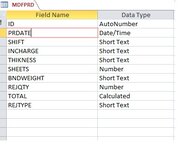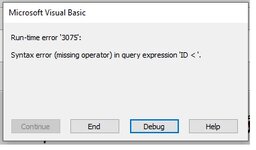-
If you would like to post, please check out the MrExcel Message Board FAQ and register here. If you forgot your password, you can reset your password.
You are using an out of date browser. It may not display this or other websites correctly.
You should upgrade or use an alternative browser.
You should upgrade or use an alternative browser.
SET TEXTBOX VALUE TO LAST SAVED VALUE
- Thread starter Shafique
- Start date
Excel Facts
Ambidextrous Undo
Undo last command with Ctrl+Z or Alt+Backspace. If you use the Undo icon in the QAT, open the drop-down arrow to undo up to 100 steps.
Not really possible to solve with only one piece of sample data. According to your post, if you have
the previous to the last "saved" record value is likely 01/04/2022 - sometimes. However, if I edit the records thus:
then the last saved record is ID 3 so the previous value is 01/02/2022.
Regardless, you will probably have to create a sub query. How that would look depends on what it is you exactly want.
| ID | DateVal | ||||||
1 | 1/01/22 | ||||||
2 | 1/02/22 | ||||||
3 | 1/03/22 | ||||||
4 | 1/04/22 | ||||||
5 | 1/05/22 |
the previous to the last "saved" record value is likely 01/04/2022 - sometimes. However, if I edit the records thus:
| ID | DateVal | ||||||
1 | 1/01/22 | ||||||
2 | 1/02/22 | ||||||
3 | 1/15/22 | ||||||
4 | 1/04/22 | ||||||
5 | 1/05/22 |
Regardless, you will probably have to create a sub query. How that would look depends on what it is you exactly want.
Upvote
0
CraigYellick
New Member
- Joined
- Jul 15, 2022
- Messages
- 2
- Office Version
- 365
- Platform
- Windows
The Access event model for bound controls is pretty slick. You could capture the previous value in the BeforeUpdate event, like so:
VBA Code:
Dim previousValue
Private Sub txtExample_BeforeUpdate(Cancel As Integer)
previousValue = txtExample.OldValue
End Sub
Upvote
0
YES.Not really possible to solve with only one piece of sample data. According to your post, if you have
ID DateVal
the previous to the last "saved" record value is likely 01/04/2022 - sometimes. However, if I edit the records thus:
then the last saved record is ID 3 so the previous value is 01/02/2022.
ID DateVal
Regardless, you will probably have to create a sub query. How that would look depends on what it is you exactly want.
you are Right. then what to do in backend code that when i start posting in ID 6 row and in txtdate textbox get automatically ID 5's txtdate value (1/05/22)
Upvote
0
If
- primary key field of form record is named ID
- form control that gets the value you want is named txtDate
- table date field is named DateVal
then try using the form AfterUpdate event as per code below. This would only work where a new record is being created, which is what you seem to be asking for:
- primary key field of form record is named ID
- form control that gets the value you want is named txtDate
- table date field is named DateVal
then try using the form AfterUpdate event as per code below. This would only work where a new record is being created, which is what you seem to be asking for:
VBA Code:
If Me.NewRecord Then
txtDate = DLookup("[DateVal]", "[Table Name Here]", "ID = " & Me.ID - 1)
End If
Upvote
0
thanks for your effortIf
- primary key field of form record is named ID
- form control that gets the value you want is named txtDate
- table date field is named DateVal
then try using the form AfterUpdate event as per code below. This would only work where a new record is being created, which is what you seem to be asking for:
VBA Code:If Me.NewRecord Then txtDate = DLookup("[DateVal]", "[Table Name Here]", "ID = " & Me.ID - 1) End If
I tried this code same as you typed but it comes with this error massage
syntax error (missing operator) in query expression 'ID='.
So i am sending you my table design view where i am get stuck. the DateVal Field is in my table named with PRDATE
Attachments
Upvote
0
I just remembered there is no guarantee that the prior ID value is one less than the record being added. This should be safer to use:
txtDate = DMax("[DateVal]", "[Table Name Here]", "ID < " & Me.ID)
What you really want is the Max of the value that is less than the value just added.
Edit - Saw that you had posted just after I hit save. Will look at what you posted now.
txtDate = DMax("[DateVal]", "[Table Name Here]", "ID < " & Me.ID)
What you really want is the Max of the value that is less than the value just added.
Edit - Saw that you had posted just after I hit save. Will look at what you posted now.
Upvote
0
Many others have written that they tried what was posted, only to find out that is not really the case. Post your code attempt please.
and ignore last posted suggestion. It will be wrong too. Working on it.
and ignore last posted suggestion. It will be wrong too. Working on it.
Last edited:
Upvote
0
SAME errorI just remembered there is no guarantee that the prior ID value is one less than the record being added. This should be safer to use:
txtDate = DMax("[DateVal]", "[Table Name Here]", "ID < " & Me.ID)
What you really want is the Max of the value that is less than the value just added.
Edit - Saw that you had posted just after I hit save. Will look at what you posted now.
syntax error (missing operator) in query expression 'ID<'.
Attachments
Upvote
0
txtDate = DLookup("PRDDATE", "MDFPRD", "ID = " & DMax("ID", "MDFPRD", "ID < " & Me.ID))
Our posts are crossing. Note that the red/blue parts are associated with each other.
Firstly, I after looking at your table pic I realized that you need a date based based on the ID that is the highest value but is less than the current record ID value.
So post your actual code or see what happens if you put in any valid ID number instead, such as
txtDate = DLookup("PRDDATE", "MDFPRD", "ID = 5"). Also, form must have the ID field on it, otherwise Me.ID will raise an error. If not there, try adding it (you don't have to make it visible). The PK field should always be on a form/report in case it becomes necessary - such as in this case.
EDIT - company coming; not sure how much time I will have for this today.
Our posts are crossing. Note that the red/blue parts are associated with each other.
Firstly, I after looking at your table pic I realized that you need a date based based on the ID that is the highest value but is less than the current record ID value.
So post your actual code or see what happens if you put in any valid ID number instead, such as
txtDate = DLookup("PRDDATE", "MDFPRD", "ID = 5"). Also, form must have the ID field on it, otherwise Me.ID will raise an error. If not there, try adding it (you don't have to make it visible). The PK field should always be on a form/report in case it becomes necessary - such as in this case.
EDIT - company coming; not sure how much time I will have for this today.
Upvote
0
Solution
Similar threads
- Question
- Replies
- 6
- Views
- 222
- Replies
- 2
- Views
- 342
- Question
- Replies
- 5
- Views
- 197
- Replies
- 8
- Views
- 268
- Question
- Replies
- 5
- Views
- 542







